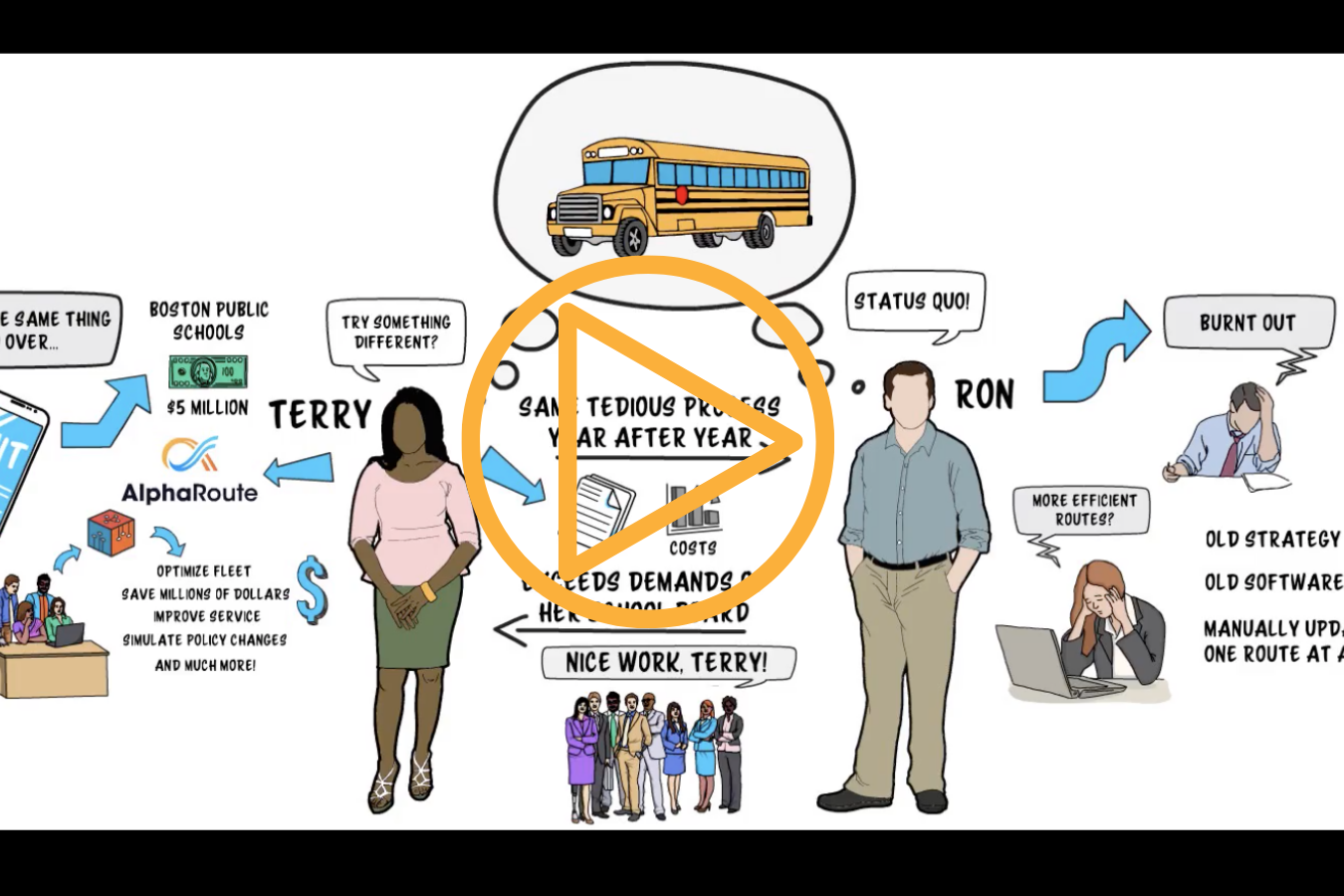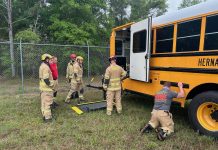This content is brought to you by AlphaRoute.
The driver shortage is hurting school bus operations everywhere. This is not a myth.
But there are myths related to the shortage, and they are making a difficult year even more challenging. One company is exposing the myths and bringing hope to transportation departments in the form of lower bus counts and reduced staff burnout.
AlphaRoute uses MIT-based algorithms to optimize districtwide bus fleets. Their award-winning approach converts routing plans into math problems which can be solved objectively, and the solutions provide breathing room amidst the driver shortage: AlphaRoute’s solutions often use 10% to 30% fewer buses than the status quo, as Columbus, Ohio found out earlier this year.
“Mission accomplished! Insights from AlphaRoute allowed us to consolidate routes from 704 to 558 and get all eligible students routed to a bus. Highly recommended!”
– Rob Weinheimer, Director of Transportation, Columbus City Schools
AlphaRoute staff have talked to transportation directors across the U.S. and Canada and have followed the driver shortage crisis as closely as anyone. Doing so has allowed them to identify and debunk the following five myths which are exacerbating an already difficult situation.
5 Driver Shortage Myths Debunked by AlphaRoute
1. All we can do is try to recruit more drivers.
Districts everywhere would benefit from having more drivers. But spending time and resources on recruiting efforts alone is not the best or only thing that can be done. Many districts report hiring drivers at a higher rate than usual but losing them just as fast. A Florida transportation director recently described recruiting programs as “CDL mills,” with many new hires getting their CDL and then promptly leaving for higher-paying jobs.
If an all-out focus on recruiting isn’t generating the desired results, then why do some districts seem so hyper-focused on it? AlphaRoute has shown that optimizing routes is an even more effective strategy to confront the shortage, allowing districts to transport more students with fewer drivers… and building these solutions in less time than it takes to conduct one job fair.
2. If we can just get through this year, then we’ll be fine.
The shortage is not temporary. Transportation teams know that the shortage has been growing in severity in recent years. It did not come about solely because of Covid-19 and it will not go away when Covid-19 is over. Instead, it may only get worse, as the average bus driver age continues trending upward and as the on-demand economy continues to grow and pull drivers into higher-paying jobs.
Districts need a solution that can change with the times, and they need to be prepared for the shortage to continue into next year and beyond.
3. Our routes are already optimized.
In most cases, they are not. School district routing teams are among the smartest problem-solvers in public education, but it is not humanly possible to build optimal districtwide route-sets without software and algorithms capable of meeting that challenge. Routing specialists and their software can convert a set of bus stops into a single, optimal bus route, and they can do that one route at a time, one school at a time, but this is an incredibly time-consuming process that does almost nothing for optimizing the district as a whole.
“We hear from school systems all the time who tell us their routes are already optimized, usually because they’re using expensive software or because they brought in consultants who conducted a study,” said John Hanlon, CEO of AlphaRoute and the former COO of Boston Public Schools. “What these districts don’t understand is that their software platforms are not actually capable of optimizing their entire fleets like we can. Maybe they can do it at the route level but not across the entire district. Most of our work is with districts who use market-leading software, and yet we still outperform their status quo by as much as 30 percent.”
“I understand the skepticism when districts don’t believe that,” Hanlon added. “That’s why we offer to build a baseline routing solution for free, to show how we can provide true optimality while actually improving service.”
True optimality, as the AlphaRoute team has demonstrated, comes from objectifying large-scale bus routing, turning it into a math problem that can be solved by advanced algorithms. The team’s technology represents a major departure from how district bus routing is done today, and as a result many districts think their routes are optimized when in reality they are not.
4. We’ve had no choice but to cut routes and limit service.
Districts do have a choice, and yet route cancellations are often characterized as a “last resort.” Until a district has truly optimized its bus routes or examined less disruptive changes, it is not necessary to cancel anything.
But news reports abound with districts who have canceled service. One large district in the Pacific Northwest recently removed service for a quarter of its students. Others have employed rolling route suspension schedules.
None of this is necessary.
AlphaRoute reduced Columbus City’s bus count from 704 to 558 with only minor changes in practice or policy, enabling all eligible students to be assigned to a bus.
The Columbus example highlights two AlphaRoute specialties: the ability to simulate multiple routing conditions and the ability to do it quickly. As Weinheimer said, “They worked quickly and efficiently to provide multiple routing solutions that only took 4 weeks.”
5. We’re covered for now; we’ll be OK.
The rise in school bus driver strikes and sick-outs proves this is likely not the case, even for many who do not think they have a driver shortage. Districts everywhere are doing whatever they can to get by, but in many cases this results in increased staff burnout and frustration, as the current driver force is expected to do more than what they are accustomed to, driving double runs and working longer hours.
This has had a toll in many districts, leading to labor unrest and a continued driver exodus. The last 3 weeks alone have seen driver protests and widespread sick-outs in Florida, North Carolina, Maryland, and other areas. More will certainly follow.
This has been happening in districts that started the year with massive driver shortages and in districts that barely had enough to cover their operations.
The second group, the ones who were “getting by,” have understood all along that increasing the workload for the existing driver force and putting everyone with a CDL behind the wheel are not sustainable strategies. One transportation coordinator in Ontario recently reported that they were on the “razor’s edge,” technically covered but running into problems each day due to normal absenteeism. Still, the hope for many school systems in this category is that they’ll weather this situation until new drivers come in to save the day.
That loops back to the first myth above and the reality that the number of new drivers needed in many places will not materialize. What happens instead – and what is happening right now for school bus operations everywhere – is a self-reinforcing negative spiral: Districts do not have enough drivers, so they have to work their current drivers even more, which causes more of them to leave or to stage sick-outs, which leaves these districts with even fewer drivers….
Solely focusing on recruiting efforts or cutting service are not effective answers to this dilemma. They are either short-sighted or blunt-force strategies to solve a broken equation: The thinking being that if there aren’t enough drivers to perform the routes then districts need to either hire more drivers or slash their routes. But what if the routes were more efficient? What if the run-pairs were built differently? What if the entire routing system were fully optimized?
AlphaRoute has shown that districts would do well if they started asking those questions. And when they do they will likely find that AlphaRoute is the answer.
AlphaRoute’s unique, MIT-based approach truly works. That is not a myth.
Contact AlphaRoute today for a free demo, browse our website, or view the following video to learn more about our proven approach to optimizing bus routing plans.
















